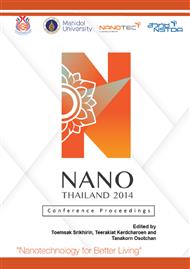[1]
Sunandan Baruah, Samir K. Pal, and Joydeep Dutta, Nanostructured Zinc Oxide for Water Treatment. Nanoscience & Nanotechnology-Asia, 2012. 4(2).
DOI: 10.2174/2210681211202020090
Google Scholar
[2]
Lonnen, J., et al., Solar and photocatalytic disinfection of protozoan, fungal and bacterial microbes in drinking water. Water Research, 2005. 39(5): pp.877-883.
DOI: 10.1016/j.watres.2004.11.023
Google Scholar
[3]
Rincon, A.G. and C. Pulgarin, Bactericidal action of illuminated TiO2 on pure Escherichia coli and natural bacterial consortia: Post-irradiation events in the dark and assessment of the effective disinfection time. Applied Catalysis B: Environmental, 2004. 49(2): pp.99-112.
DOI: 10.1016/j.apcatb.2003.11.013
Google Scholar
[4]
Adams, L.K., D.Y. Lyon, and P.J.J. Alvarez, Comparative eco-toxicity of nanoscale TiO2, SiO2, and ZnO water suspensions. Water Research, 2006. 40(19): pp.3527-3532.
DOI: 10.1016/j.watres.2006.08.004
Google Scholar
[5]
Huang, N., et al., Photochemical disinfection of Escherichia coli with a TiO2 colloid solution and a self-assembled TiO2 thin film. Supramolecular Science, 1998. 5(5-6): pp.559-564.
DOI: 10.1016/s0968-5677(98)00074-1
Google Scholar
[6]
Qi, L., et al., Preparation and antibacterial activity of chitosan nanoparticles. Carbohydrate Research, 2004. 339(16): pp.2693-2700.
DOI: 10.1016/j.carres.2004.09.007
Google Scholar
[7]
Sondi, I. and B. Salopek-Sondi, Silver nanoparticles as antimicrobial agent: A case study on E. coli as a model for Gram-negative bacteria. Journal of Colloid and Interface Science, 2004. 275(1): pp.177-182.
DOI: 10.1016/j.jcis.2004.02.012
Google Scholar
[8]
Krishna, V., et al., Mechanism of enhanced photocatalysis with polyhydroxy fullerenes. Applied Catalysis B: Environmental, 2008. 79(4): pp.376-381.
DOI: 10.1016/j.apcatb.2007.10.020
Google Scholar
[9]
Gelover, S., et al., A practical demonstration of water disinfection using TiO2 films and sunlight. Water Research, 2006. 40(17): pp.3274-3280.
DOI: 10.1016/j.watres.2006.07.006
Google Scholar
[10]
Ibanez, J.A., M.I. Litter, and R.A. Pizarro, Photocatalytic bactericidal effect of TiO2 on Enterobacter cloacae. Comparative study with other Gram (-) bacteria. Journal of Photochemistry and Photobiology A: Chemistry, 2003. 157(1): pp.81-85.
DOI: 10.1016/s1010-6030(03)00074-1
Google Scholar
[11]
Erkan, A., U. Bakir, and G. Karakas, Photocatalytic microbial inactivation over Pd doped SnO2 and TiO2 thin films. Journal of Photochemistry and Photobiology A: Chemistry, 2006. 184(3): pp.313-321.
DOI: 10.1016/j.jphotochem.2006.05.001
Google Scholar
[12]
Baruah, S. and J. Dutta, Hydrothermal growth of ZnO nanostructures. Science and Technology of Advanced Materials, 2009. 10(1): p.013001.
DOI: 10.1088/1468-6996/10/1/013001
Google Scholar
[13]
Baruah, S., et al., Photocatalytic paper using zinc oxide nanorods. Science and Technology of Advanced Materials, 2010. 11(5).
Google Scholar
[14]
Najam Khan, M., et al., Visible light photocatalysis of mixed phase zinc stannate/zinc oxide nanostructures precipitated at room temperature in aqueous media. Ceramics International, 2014. 40(6): pp.8743-8752.
DOI: 10.1016/j.ceramint.2014.01.094
Google Scholar
[15]
Al-Hinai, A.T., M.H. Al-Hinai, and J. Dutta, Application of Eh-pH diagram for room temperature precipitation of zinc stannate microcubes in an aqueous media. Materials Research Bulletin, 2014. 49(0): pp.645-650.
DOI: 10.1016/j.materresbull.2013.10.011
Google Scholar
[16]
Najam Khan, M. and J. Dutta, Comparison of photocatalytic activity of zinc stannate particles and zinc stannate/zinc oxide composites for the removal of phenol from water, and a study on the effect of pH on photocatalytic efficiency. Materials Science in Semiconductor Processing, 2015. 36(0): pp.124-133.
DOI: 10.1016/j.mssp.2015.03.011
Google Scholar
[17]
Najam Khan, M., Comparison of different zinc stannate structures synthesized at room temperature for photodegradation of dyes and phenol, in Nanotechnology. 2014, Asian Institute of Technology: Bangkok.
Google Scholar
[18]
Baruah, S., M. Jaisai, and J. Dutta, Development of a visible light active photocatalytic portable water purification unit using ZnO nanorods. Catalysis Science & Technology, 2012. 2(5): pp.918-921.
DOI: 10.1039/c2cy20033c
Google Scholar
[19]
Zhang, Y., et al., Hydrothermal synthesis and characterization of single-crystalline zinc hydroxystannate microcubes. Journal of Crystal Growth, 2007. 308(1): pp.99-104.
DOI: 10.1016/j.jcrysgro.2007.07.030
Google Scholar
[20]
ATMACA;, S., K. GÜL;, and R. ÇİÇEK, The Effect of Zinc On Microbial Growth. Tr. J. of Medical Sciences, 1998. 28: pp.595-597.
Google Scholar
[21]
Barry, A.L., et al., Methods of measuring zones of inhibition with the Bauer-Kirby disk susceptibility test. Journal of Clinical Microbiology, 1979. 10(6): pp.885-889.
DOI: 10.1128/jcm.10.6.885-889.1979
Google Scholar


